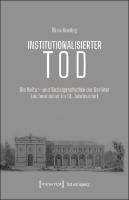Institutionalisierter Tod
Die Kultur- und Sozialgeschichte der Berliner Leichenhäuser im 19. Jahrhundert
Abstract
Die Feststellung des Todes war lange Zeit keine eindeutige Angelegenheit. Als eine Folge breitete sich seit der Mitte des 18. Jahrhunderts die Angst vor dem Lebendig-begraben-Werden scheintoter Menschen in Europa aus. Die neue Institution der Leichenhäuser sollte die Unterscheidung zwischen Leben und Tod gewährleisten. Nina Kreibig arbeitet beginnend mit dem ersten Leichenhaus von 1794 bis zur Reichsgründung 1871 die Kultur- und Sozialgeschichte der Berliner Einrichtungen systematisch auf und analysiert ihren Umgang mit und die Bewertung von Verstorbenen.
Keywords
Tod; Scheintod; Leichenhaus; Berlin; Angst; 19. Jahrhundert; Institutionalisierung; Kulturgeschichte; Medizin; Deutsche Geschichte; Sozialgeschichte; Geschichte des 19. Jahrhunderts; Geschichtswissenschaft; Death; Seemsod; Mortuary; Fear; 19th Century; Institutionalization; Cultural History; Medicine; German History; Social History; History of the 19th Century; HistoryDOI
10.14361/9783839463406ISBN
9783839463406, 9783837663402, 9783839463406Publisher
transcript VerlagPublisher website
https://www.transcript-verlag.de/Publication date and place
Bielefeld, 2022Grantor
Imprint
transcript VerlagSeries
Tod und Agency. Interdisziplinäre Studien zum Lebensende, 2Classification
European history
Social and cultural history


 Download
Download